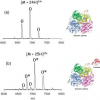Articles
Luc Alexis Leuthold, Emmanuel Varesio and Gérard Hopfgartner
Life Sciences Mass Spectrometry, School of Pharmaceutical Sciences, EPGL, University of Geneva, University of Lausanne, 20 Bd d’Yvoy, 1211 Geneva 4, Switzerland
Frédéric Aubriet,* Vincent Carréa and Jean-François Muller
Laboratoire de Spectrométrie de Masse et de Chimie Laser, Université Paul Verlaine–Metz, 1, Boulevard Arago, F-57078 Metz Technopole 2000 Cedex 03, France. E-mail: [email protected]
aPresent address: UMR CNRS 8522, Physicochimie des Processus de Combustion et de l’Atmosphère, LCPA–Université d’Artois, Parc Porte Nord, 62700 Bruay-la-Buissière, France
Rich Sleeman, Jim Carter and Karl Ebejer
Mass Spec Analytical Ltd, Building 20F, Golf Course Lane, Filton, Bristol, BS99 7AR, UK
Lutz Hartiga and Kristin von Czapiewskib
aEurofins, Wiertz-Eggert-Jörissen GmbH, Stenzelring 14b, 21107 Hamburg, Germany
bApplied Biosystems, Applera Deutschland GmbH, Franfurter Straße 129 B, 64293 Darmstadt, Germany
Anton Amann,a,d Alex Schmid,a,b Sabine Scholl-Bürgi,c Stefan Telserb and Hartmann Hinterhuberb
aDepartment of Anesthesia and General Intensive Care, Innsbruck Medical University, A-6020 Innsbruck, Austria
bDepartment of Psychiatry, Sleep Laboratory, Innsbruck Medical University, A-6020 Innsbruck, Austria
cClinical Department of General Paediatrics, Innsbruck Medical University, A-6020 Innsbruck, Austria
Heidi Goenaga-Infante and Mike Sargent
LGC Limited, Queens Road, Teddington, Middlesex TW11 OLY, UK. E-mail: [email protected]
Frank Rutten,* Julian Hendersona and David Briggs
School of Pharmacy and Centre for Surface Chemical Analysis,
aDepartment of Archaeology, School of Humanities, University of Nottingham, University Park, Nottingham NG7 2RD, UK
*Correspondence to: Frank Rutten, School of Pharmacy, University of Nottingham University Park, Nottingham NG7 2RD, UK. E-mail: [email protected]
Erwin Hoffmanna and Christian Lüdkeb
aGOS - Gesellschaft zur Förderung angewandter Optik, Optoelektronik, Quantenelektronik und Spektroskopie eV, Rudower Chaussee 29, 12489 Berlin, Germany. E-mail: [email protected]
bISAS–Institute for Analytical Sciences, Department Berlin, Albert-Einstein-Str. 9, 12489 Berlin, Germany
Steve Down
HD Science Limited, 16 Petworth Avenue, Toton, Nottingham NG9 6JF, UK
In recent years, the newly-developed soft ionisation techniques together with the possibility to measure masses by high-resolution mass analysers with high transmission and with a broad mass-to-charge range have given mass spec-trometry the opportunity to add complementary information to the protein structural biology community.
T. Wirtz and H.-N. Migeon
Laboratoire d’Analyse des Matériaux, Centre de Recherche Public - Gabriel Lippmann, 162A, av. de la Faïencerie, L-1511 Luxembourg, [email protected]
Introduction
Glow Discharge Mass Spectrometry (GDMS) is one of the most powerful solid state analytical methods for the direct determination of traces, impurities and depth profiling of solids.1–5 Glow discharge mass spectrometers, which are commercially available with fast and sensitive electrical ion detection, allow direct trace elemental determination in solid materials with good sensitivity and precision in the concentration range lower than ng g–1.6
Dipl. Chem. FH Ch. Schanzer and Prof. Dr H.G. Bührer
Department of Chemistry, Zurich University of Applied Sciences Winterthur (ZHW), CH-8401 Winterthur, Switzerland


